ADDENDUM TO STIPULATION OF SETTLEMENT/AGREEMENT RE: COMPLIANCE WITH DOMESTIC RELATIONS LAW 255(2)
___________________________ VS ___________________________ INDEX #:_________
Each party is aware that he or she will no longer be covered by the other party’s health insurance plan and that each party shall be responsible for his or her own health insurance coverage, and may be entitled to purchase health insurance on his or her own through a COBRA option, if available.
Dated: |
, 20_____ |
___________________________________ |
|
|
Plaintiff’s Signature |
|
|
___________________________________ |
|
|
Print Name |
SS:STATE OF __________________, COUNTY OF _______________
On this ______ day of ____________ 20____ , before me; the undersigned,
personally appeared ___________________, personally known to me or proved to me on the basis
of satisfactory evidence to be the individual whose name is subscribed to the within instrument and acknowledged to me that he/she executed the same in his/her capacity, and that by his/her signature on the instrument, the individual, or the person upon behalf of which the individual acted, executed the instrument.
________________________
NOTARY PUBLIC |
|
|
Dated: |
, 20_____ |
____________________________________ |
|
|
Defendant’s Signature |
|
|
____________________________________ |
|
|
Print Name |
SS:STATE OF __________________, COUNTY OF _______________
On this ______ day of ____________ 20____ , before me; the undersigned,
personally appeared ___________________, personally known to me or proved to me on the basis
of satisfactory evidence to be the individual whose name is subscribed to the within instrument and acknowledged to me that he/she executed the same in his/her capacity, and that by his/her signature on the instrument, the individual, or the person upon behalf of which the individual acted, executed the instrument.
________________________
NOTARY PUBLIC
